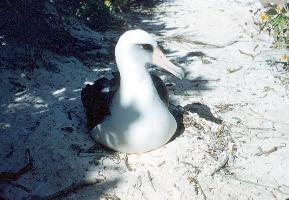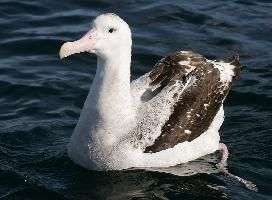
Greutăți și măsuri
| Lungimea anvergurii aripilor | 3 m |
|---|
Date biologice
| Durata de viață | de la 40 la 50 ani |
|---|
Starea de conservare
| Amenințat |
Descrierea animalului
The Laysan albatross, scientifically known as Phoebastria immutabilis, is a remarkable bird species primarily known for its incredible long-distance flight capabilities and its significant role within marine ecosystems. This species belongs to the Diomedeidae family, which encompasses the albatrosses, some of the largest flying birds in the world. The Laysan albatross is distinguished by its impressive wingspan, which can reach up to nearly 7 feet (about 2.1 meters), enabling it to glide effortlessly over vast stretches of ocean.Physically, the Laysan albatross presents a predominantly white plumage with black upper wings and back. Its head is also white, and it has a conspicuous patch of dark plumage around its eye, giving it a unique appearance. The bird's beak is large, pinkish, and hooked at the tip, an adaptation that aids in its diet of squid, fish, and crustaceans. One of the most striking features of this albatross is its ability to live a long life; some individuals have been known to live over 60 years, making them among the longest-lived bird species.
The Laysan albatross is a highly pelagic bird, spending the majority of its life at sea, where it can be found across the North Pacific Ocean, from the western coast of North America to the eastern coast of Asia. It is only during the breeding season that these birds come ashore, congregating in large colonies on isolated islands. Notably, the Northwestern Hawaiian Islands serve as a critical breeding ground for the majority of the world's Laysan albatross population.
Breeding is a significant part of the Laysan albatross's life cycle, with a fascinating courtship display that includes a complex series of dances and vocalizations. These birds are monogamous, often forming lifelong pairs. The female lays a single egg, which both parents incubate and protect. After hatching, the chick is fed by regurgitation until it is ready to fledge and take to the sea, a process that takes about five to six months. This extended parental care ensures that the chick is well-prepared for the demands of oceanic life.
Conservation efforts are crucial for the Laysan albatross due to threats such as plastic ingestion, bycatch in fishing operations, habitat destruction, and climate change. These challenges have led to a concerted effort among conservationists, governments, and local communities to protect these majestic birds and their habitats. Measures include habitat restoration, stricter fishing regulations, and public education campaigns aimed at reducing plastic pollution in the oceans.
In summary, the Laysan albatross is a fascinating and resilient bird, emblematic of the beauty and complexity of marine ecosystems. Its remarkable adaptations for long-distance flight, its intricate social behaviors, and its role in the oceanic food web underscore the importance of conserving marine biodiversity. As efforts continue to mitigate the threats facing these birds, the Laysan albatross serves as a symbol of hope and a reminder of the interconnectedness of life on Earth.
Animale similare
Fotografii noi cu animale
Top 10 animale
- Dolphin gull (Leucophaeus scoresbii)
- Diana monkey (Cercopithecus diana)
- Moustached guenon (Cercopithecus cephus)
- Greek tortoise (Testudo graeca)
- Stone loach (Barbatula barbatula)
- Galápagos tortoise (Geochelone nigra complex)
- Japanese macaque (Macaca fuscata)
- Russian tortoise (Testudo horsfieldii)
- Common flying dragon (Draco volans)
- Galápagos penguin (Spheniscus mendiculus)
